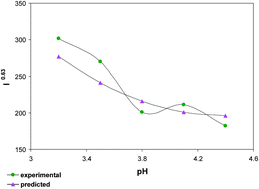Optimization of Tribenuron-methyl determination by differential pulse polarography using experimental design
Abstract

* Corresponding authors
a Phytochemistry Department, Medicinal Plants and Drugs research Institute, Shahid Beheshti University, PO Box 19835-389, Evin, Tehran, Iran
b Department of Chemistry, Shahid Beheshti University, P.O. Box 19396-4716, Evin, Tehran, Iran
c
Department of Chemistry, Sharif University of Technology, P.O. Box 11155-9516, Tehran, Iran
E-mail:
jalali@sharif.edu
Fax: +98 21 6601 2983
d
Pharmaceutical and Medicinal Chemistry Department, National Research Centre, Dokki, Cairo, Egypt
E-mail:
enein@gawab.com
Fax: +202-33370931
e Department of Chemistry, Universiti Teknologi Malaysia (UTM), Skudai, Johor Darul Ta'azim, Malaysia

 Please wait while we load your content...
Something went wrong. Try again?
Please wait while we load your content...
Something went wrong. Try again?
S. Ahmadi, A. Ghassempour, A. R. Fakhari, M. Jalali-Heravi and H. Y. Aboul-Enein, Anal. Methods, 2010, 2, 41 DOI: 10.1039/B9AY00068B
To request permission to reproduce material from this article, please go to the Copyright Clearance Center request page.
If you are an author contributing to an RSC publication, you do not need to request permission provided correct acknowledgement is given.
If you are the author of this article, you do not need to request permission to reproduce figures and diagrams provided correct acknowledgement is given. If you want to reproduce the whole article in a third-party publication (excluding your thesis/dissertation for which permission is not required) please go to the Copyright Clearance Center request page.
Read more about how to correctly acknowledge RSC content.
 Fetching data from CrossRef.
Fetching data from CrossRef.
This may take some time to load.
Loading related content
